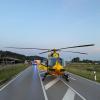‘Mossad set up drone base at Tehran for attack on Iranian anti -aircraft weather’
/s3/static.nrc.nl/images/gn4/stripped/data133626917-95c414.jpg|https://images.nrc.nl/ytPPSkvaq82g81G9_4ugsRJNEQI=/1920x/filters:no_upscale()/s3/static.nrc.nl/images/gn4/stripped/data133626917-95c414.jpg|https://images.nrc.nl/YyxEyeBQvXEfM5WWLnIf4qNc82Q=/5760x/filters:no_upscale()/s3/static.nrc.nl/images/gn4/stripped/data133626917-95c414.jpg)
It is starting to become a trend: attack the enemy behind the lines with drones. The Israeli attacks on the Iranian order chain and the atomic program also contain an element that resembles the recent attack of Ukraine on Russian airports in the hinterland.
According to the Israeli news site N12 Mossad agents with drones from Iran themselves have « precisely and effectively » attacked in different places in anti-aircraft batteries (anti-aircraft) around important objects, according to safety sources that N12 quotes. There would even be a « drone base » that the Mossad would have set up near Tehran « during months of preparation. »
The attacking of air target batteries was needed to clear the road for Israeli combat aircraft. According to The War Zonean American platform for defense news, who devotes an initial analysis to the attacks And the reporting from N12 could, among other things, explain why the Iranian anti -aircraft weather was hardly active in the Night of the Israeli bombing.
Israel also has Video images released On which Israeli commands would be shown with drones and other weapon systems. Those images are not independently verified. The Ukrainian drones were launched from trucks and attacked goals independently. What both attacks share is the surprise element of an attack from a short distance, ‘from the inside’ and against strategic targets.
Incidentally, the Iranian air defense was already weakened after a major attack in October last year, when analysts said that Israel made so ‘corridors’ to fly in Iranian airspace unhindered.
No indications for help vs
Although details are missing and the attacks are probably only in the first phase, Israel says he had used 200 aircraft in the first attack waves that would have used more than three hundred bombs and guided weapons. It is obvious that the vanguard was formed by the F-35, of which Israel has 39 and which are poor or not perceptible for the Iranian radar.
In the following waves, F-15s and F-16s would have been used that still form the grand part of the Israeli Air Force. Israel’s scope is not unlimited, because these planes have to travel a great distance and be refueled in the air, while Israel has only a limited number of tanker aircraft. There are no indications that the US, which have many more tanker aircraft in the region, have given help this time. Military analysts assume that Israel used the Syrian and Iraqi airspace to reach Iran for these attacks. It has free play there.
Photo Amir Cohen/Reuters
The Israeli attacks follow a classic pattern at the same time: the attacker first tries to get air dominant by blinding the enemy anti-aircraft weather by eliminating his search and fire control radars and then the anti-aircraft missiles themselves follow. There is even a term for: Suppression of Enemy Air Defenses (Sead). A fixed part is also the undermining of the ability to hit back; Israel also attacked Iran’s military industry, including production lines for ballistic rockets.
In earlier attacks in Gaza and Lebanon, Israel addressed his attacks against political and military key figures in the initial phase. It is now copying that method in Iran. In addition to high soldiers, including General Mohammad Bagheri, Iran’s highest soldier, and General Hossein Salami, head of the Iranian Revolutionary Guard (IRG), de facto a second Iranian force, Israel atomic scholars chose the target. According to some reports, Israel would have tried to eliminate many more people.
Radioactivity
Nor are there few details about damage to Iranian nuclear facilities. Israel said on Friday that he had « damaged » the installation in Natanz. The International Atomic Agency IAEA said to have been informed by Iran on Friday that in Natanz, one of the attacked places where Iran Uranium enriches, no increased radioactivity levels have been observed. Two other nuclear installations, in Fordow and Isfahan, would not have been attacked (yet).
Nor is it clear whether Israel is able to cause definitive damage to the links in the Iranian atom program, which – and that was the reason to strike now – would be close to the production of several atomic bombs. That claim is generally disputed, among other things by the United States. The installations are spread throughout the country and none of them are indispensable in itself. In particular, the Opwerkingstallatie in Fordow, near Qom and laid out under a mountain, would be virtually invulnerable.
Read also
Israël’s attack on Irans Nuclear program is a gamble
Destroying such an object would even require several attacks with the most heavy conventional weapon: a 15,000 kilos of heavy Bunker Buster,, » different experts said in Aprilwhen the tension started to rise. Only the US-as far as is known-have that weapon and aircraft that can throw that weapon in a war, including the B-2-bomber.
It is assumed that all Iranian nuclear installations are largely underground and protected by concrete of tens of meters deep. According to The Economist Israel may have tried to put the installations out of use bombing inputs, tunnels and ventilation dockers. According to one by the Financial Times cited expertRobert Pape, is « the Israeli air weapon not able to stop the Iranian nuclear program. » That probably certainly applies without active support from the US.

:format(webp)/s3/static.nrc.nl/images/gn4/stripped/data133626062-8f0fb1.jpg)
:format(webp)/s3/static.nrc.nl/images/gn4/stripped/data133626914-70db93.jpg)
:format(webp)/s3/static.nrc.nl/images/gn4/stripped/data124896364-ac575d.jpg)
/s3/static.nrc.nl/images/gn4/data133617085-6b0516.jpg)




